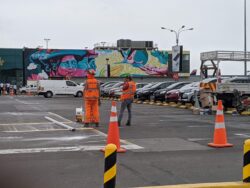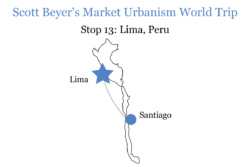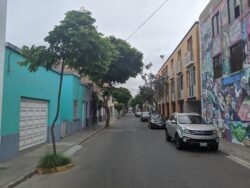Latin America’s Fabulous Indian Branding
Peru leans into its Incan heritage, and other countries to their roots.
I visited Lima, Peru on my Global South tour. Although it was conquered by Spanish conquistador Francisco Pizarro in the 16th century, the city proudly displays its native heritage everywhere. Companies include Incan branding, like a soft drink called “Inca Kola” and a textile company called “Incalpaca.” There is native public art on highways and airports. I visited a marketplace, Mercado Indio (or Indian Market), where you can buy traditional Peruvian crafts like ceramics and jewelry. The indigenous heritage is also found architecturally in buildings and public areas, and it’s true of other Latin American countries, creating a vernacular that complements the region’s Spanish legacy planning.

It’s no surprise that Peru leans into this heritage because it’s a huge tourist draw. Over a million people visit Machu Picchu every year. The Incan citadel is located high in the Andes mountains of Peru. Machu Picchu was used as a royal estate for an Incan emperor from 1420-1530. It was abandoned after the Incan Empire was conquered by the Spanish. It was re-discovered by archeologists in 1911. The ruins remind visitors that before Europeans came to America, the Incans had a huge, technologically advanced empire with unique urbanism.

Machu Picchu is an architectural marvel and an impressive example of Incan planning and engineering. It’s made up of about 200 structures, which include temples, a royal tomb, storage houses for food, and residential buildings. They also had space to grow crops. The citadel was meant to inhabit 750-1000 people.
The Incans didn’t use the wheel or metal to build their impressive cities. The structures were built using granite. A technique called “ldquo ashlar” means that stones were cut with smooth, flat faces and sharp edges, so they didn’t need to use mortar. That made the buildings more resistant to earthquakes, which are common in the region.
One unique feature of Machu Picchu are the terraces. Incans built flat platforms out of stone on the steep slopes of the mountains. That helped protect the citadel landslides and also were used as drainage since it rains a lot in that part of Peru. The terraces were used for agriculture. The Incans grew corn, potatoes, and quinoa, which helped them survive the inhospitable mountain environment.
Machu Picchu was just one part of the vast Incan empire. At its peak in the 1400s, before Spanish conquest, it had 12 million people and its land stretched for 2500 miles along the west coast of South America, from Ecuador down to Santiago, Chile. The empire built 25,000 miles of roads.
Another major city in the empire was Cuzco, the Incan capital, in Southeastern Peru. It was the center of government and religion. At its peak it had about 100,000 residents. The city was built on a grid, with four districts. In the middle was a main plaza.
The Spaniards conquered Cuzco in 1533. Unlike Machu Picchu, it was not abandoned. The Spanish built over the Incan city—just as they did over much of the region’s indigenous architecture. The Spanish expanded on the existing grid system in Cuzco. On top of the main plaza, they built the Plaza de Armas, replacing religious structures with their own churches.
The most important structure in Cuzco was the Coricancha, or the Temple of the Sun. It was dedicated to Inti, the Incan sun god. The interior of the temple was lined with gold and decorated with precious stones and statues. The Spanish looted and destroyed the temple and even peeled gold off the walls to send back to Spain. In its place, they built the Church of Santo Domingo in the Baroque style. Baroque architecture, which was popular in Europe at the time, features large, open spaces, high ceilings, curved designs, and decorated facades with intricate patterns. The style gives off a sense of grandeur.

Image Credit: Diego Delso, Wikimedia Commons.
Since the Spanish conquered so many places so quickly, they created planning guidelines to rebuild cities. Early colonial towns included a main square, with a city grid around it. The colonists were instructed to build cities on places that had fertile soil, access to resources like timber and water, and ease of transport. The plazas, which were intended for gatherings and social activities, were to be built by the water if it was a coastal town, or in the middle if the city was inland. They were also instructed to build in the same kind of architectural style so their cities would look uniform and beautiful.
The result centuries later is that while LatAm cities are known for Spanish planning (especially in the old town centers), it’s really a mix of indigenous, colonial and modern. In some cases it’s a blend, such as the “Andean Baroque” style that rose in the 18th century. Two buildings in Central America, Torre Reforma of Mexico City and the central bank in Guatemala, incorporate Mayan elements into brutalism. A Bolivian architectural movement called “Neo-Andean” gives old Aymara design motifs a contemporary twist.
Perhaps LatAm’s best current reflection of indigenous architecture is favelas. The legacy of using natural, locally-sourced materials is found in the stone, adobe brick and thatched wood of these informal settlements.
Those are found all throughout LatAm, and are of course more a statement of economic hardship than some sentimental appeal to heritage. But of all my LatAm stops, Peru was the most intentional about burnishing its Indian brand, creating streetscapes that were colorful, earthy and authentic.

Except where otherwise noted, images credited to Scott Beyer and The Market Urbanist.
Catalyst articles by Scott Beyer | Full Biography and Publications
